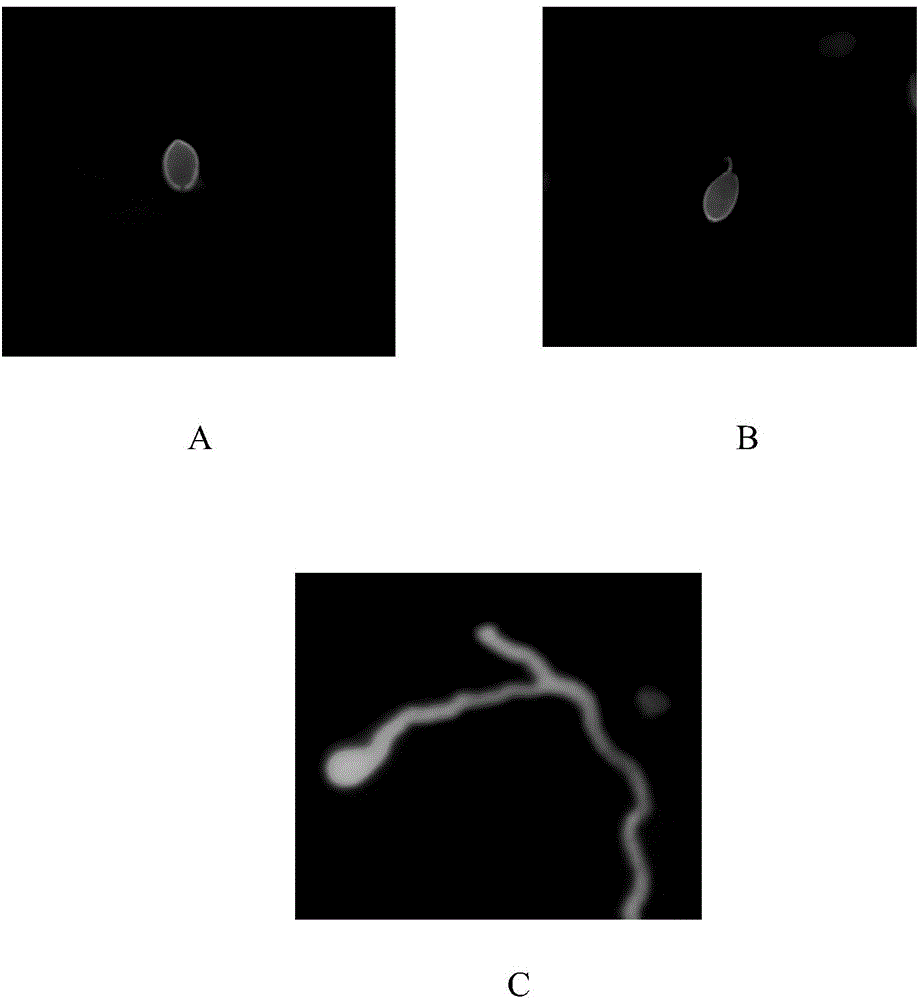Fungus fluorescence staining method and application thereof
A fluorescent dyeing and fungal technology, which is applied in the field of fluorescent dyeing, can solve the problems of time-consuming, high technical requirements for operators, and inability to express green fluorescent protein genes, etc., and achieve the effect of simple operation method and simplified dyeing steps
- Summary
- Abstract
- Description
- Claims
- Application Information
AI Technical Summary
Problems solved by technology
Method used
Image
Examples
Embodiment 1
[0028] Take the invasion process of potato late blight as an example.
[0029] 1. Materials
[0030] Potato variety and physiological race of Phytophthora infestans: The tested potato variety was Fevorita, and Phytophthora infestans was from Hunan Agricultural University.
[0031] 2. Method
[0032] Sow the tubers of the tested potato varieties in small flowerpots, and grow seedlings under the conditions of 16-20°C and 12-16 hours of sunshine. After flattening the leaves of the seedlings, use a concentration of about 1×10 5 Spray inoculation with sporangia suspension of P. infestans infestans per mL, and then move the flower pot into an artificial climate box for cultivation. The cultivation conditions are: 16-18°C, 16 hours of light, light intensity not less than 10000lx, and humidity of 100%.
[0033] The leaves were sampled at 0h, 12h, 24h, 48h, 72h, and 96h after inoculation.
[0034] The leaves of 0h, 12h, and 24h after inoculation were directly dyed, that is, the dye...
Embodiment 2
[0037] Coleomyces cowpea ( Cercospora vignae ) invasion of cowpea as an example.
[0038] The cowpea coal mold fungus came from the laboratory of the Plant Protection College of Hunan Agricultural University. The variety of cowpea is red-billed swallow, which was purchased from the Institute of Vegetables and Flowers, Hunan Academy of Agricultural Sciences.
[0039] The cowpea leaves were sampled at about 0h-5h and 72h after inoculation with cowpea coal mold fungus.
[0040] The leaves of 0-5h after inoculation are directly dyed, that is, the dyeing solution is evenly sprayed on the surface of the leaves, and then the UV-2A filter is configured (excitation filter, 330-380nm; dichroic mirror, 400nm; barrier filter 420nm) ) under a fluorescence microscope (do not add a cover glass) to observe the situation of cowpea coal mold spores on the surface of cowpea leaves, see image 3 a.
[0041] About 72 hours after inoculation, the leaf material is first decolorized and then dye...
Embodiment 3
[0043] Eggplant anthracnose bacteria ( Colletotrichum truncatum ) invasion of eggplant as an example.
[0044] Eggplant anthracnose bacteria came from the Laboratory of Plant Protection College of Hunan Agricultural University. The eggplant variety was Heiguan Zaoqie, which was purchased from the Institute of Vegetables and Flowers, Hunan Academy of Agricultural Sciences.
[0045] The eggplant leaves were sampled at about 0h-5h and 72h after inoculation with Eggplant anthracnose bacteria.
[0046] The staining method is the same as that in Example 2, and the eggplant anthracnose spores are observed under a fluorescence microscope on the eggplant leaf surface ( Figure 4 A) and mycelia of P. anthracnose in eggplant leaf tissue ( Figure 4 B) Situation.
PUM
 Login to View More
Login to View More Abstract
Description
Claims
Application Information
 Login to View More
Login to View More - R&D
- Intellectual Property
- Life Sciences
- Materials
- Tech Scout
- Unparalleled Data Quality
- Higher Quality Content
- 60% Fewer Hallucinations
Browse by: Latest US Patents, China's latest patents, Technical Efficacy Thesaurus, Application Domain, Technology Topic, Popular Technical Reports.
© 2025 PatSnap. All rights reserved.Legal|Privacy policy|Modern Slavery Act Transparency Statement|Sitemap|About US| Contact US: help@patsnap.com



